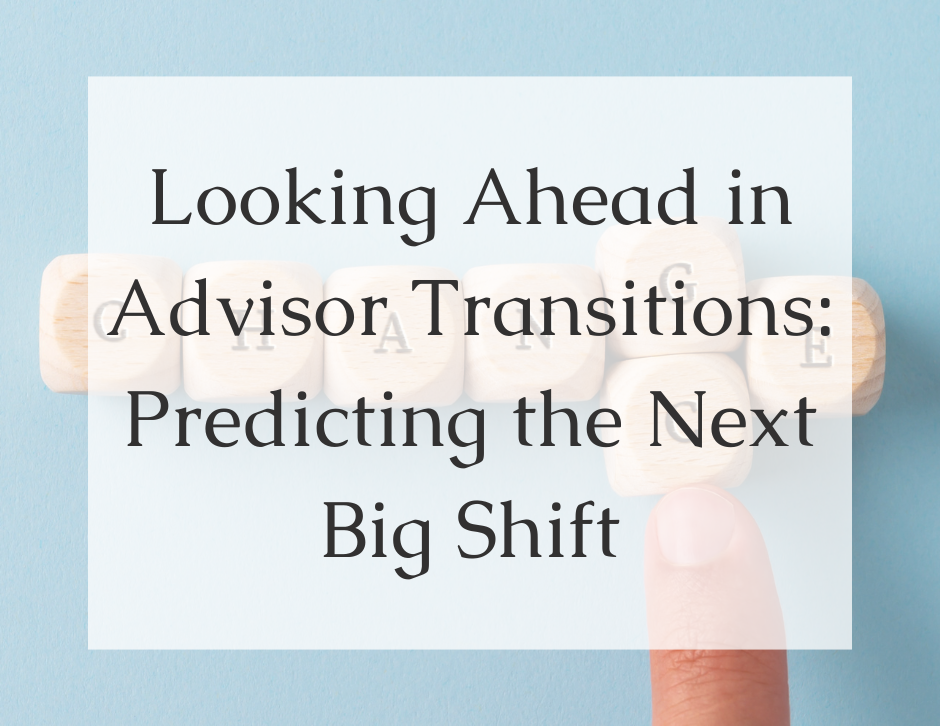Written by: Javi Otero
The Hidden Costs of Transitioning: What Every Advisor Should Consider
Change is inevitable in the world of wealth management, and advisor transitions are one of the major driving forces behind industry growth and evolution. Advisors are shedding the security blanket offered by brand name traditional firms in favor of independence, flexibility, and entrepreneurship. So, what does that mean for the future of transitions? Having spent the better part of my career in this industry as a transition consultant, I’ve been witness to the changing trends over the years and have some predictions for the future. And while I consider transitions to be serious business, I don’t want writing about them to be boring. So, let’s have a little fun with it.
Understanding these hidden costs can help you plan more effectively, avoid unpleasant surprises, and ensure a smooth, successful transition. Let’s take a closer look at what every advisor should know about the less obvious expenses of transitioning.
Prediction #1 - The Emergence of Boutique RIAs: Small Teams with Big Impact
In the same way craft beer changed the beverage landscape (who wants to drink mass-produced beer when you can enjoy a triple-hopped artisanal IPA?), boutique RIAs have risen in popularity. Many advisors are gravitating towards smaller, agile firms that provide personalized service to advisors, innovative technology, and the ability to customize services for niche markets.
Many clients love boutique RIAs because they have that “local brewery” vibe versus the “mass distribution” feel. Advisors are discovering that boutique firms promote closer relationships with clients, present less red tape, and offer more liberation to evolve. Expect this trend to accelerate over the next several years, with boutique RIAs courting high end advisor talent. But beware the aggregator RIAs charading as boutiques but sporting that not-so-flexible assembly line model behind the scenes.
Prediction #2 – Titans of Technology: A Blessing and a Curse
Technology will continue to play the role of hero and villain in the continuing evolution of the fintech landscape. On one side, the right tech tools can streamline operations, create better client experiences, and make advisors’ lives more manageable. On the other hand, advisors who succumb to “shiny object syndrome” create the potential to overload their tech stack with too many non-integrated systems. Going forward, custodians and tech providers will double-down on creating smoother, more seamless integrations, making it easier for advisors to manage everything in one place. As integrations take center stage, fintech M&A is set to surge, reshaping the industry with clear frontrunners emerging while others struggle to keep up.
Artificial Intelligence will play a larger role in data management and client communications, easing the pressure that transitions create. Due diligence will be more important than ever, because if you’re not vigilant, you may end up with a “Frankenstein” tech stack that creates more problems than it solves. The ones who will thrive in the future aren’t just those who adopt tech to fix one problem at a time, but those who leverage it strategically to drive long-term efficiency and growth.
Prediction #3 - The End of One-Size-Fits-All
Cookie-cutter transitions are becoming a relic. Every advisor’s book of business is different, and the future of transitions must be tailored. To address these differences, advisors will need customized support based on the needs of their clients, their business models, and their own personal goals.
This change will require a more consultative approach. In-depth due diligence as opposed to surface level awareness. Advisors will seek out experts who can understand their specific challenges — whether it’s managing complex accounts or navigating difficult client relationships. To those in the transition game that are still using a one-size-fits-all playbook, consider this your clarion call.
Prediction #4 - A Surge in Non-Protocol Transitions
Non-protocol transitions — situations in which advisors are leaving captive firms (that are not part of the protocol), do not technically own their book of business, and are often subject to non-solicitation clauses in their employment contracts – continue to increase in popularity. Despite their inherent complexities, the rise of social media and other resources available on the internet have made client information more accessible. Advisors are honing their detective skills and making contact with clients faster and easier.
In addition to public internet resources, access to legal and compliance professionals has increased as well. As has the chatter about the importance of contract review and existence of legal loopholes.
Over time, with more tools and resources, non-protocol transitions will be shrouded in less mystery. Existing independent firms and industry consultants will continue to provide customized solutions to help advisors reconnect with clients quickly and legally. That’s not to say that the power of memorization should be ignored. How else are you going to earn that respect from your friends on trivia night?
Prediction #5 - Embracing the Power of a Proactive Transition Strategy
Financial advisors are taking a more strategic and selective approach when researching potential RIAs to join. Digging beyond surface-level perks to evaluate compliance procedures, fee structures, technology, and post-transition support. They’re asking tough questions about onboarding, billing models, and operational efficiency – knowing that the wrong choice can cost both time, money, and clients’ trust. Peer insights and industry research are playing key roles in the decision-making process.
Beyond logistics, advisors are also assessing long-term cultural alignment. They want to know if a firm truly supports advisor autonomy, invests in individual growth in addition to overall growth, and shares their client service philosophy. The goal isn’t just to make a move to the independent space – it’s to find a strategic partner. By focusing efforts on due diligence up front, advisors can ensure they’re partnering with a firm that enhances, rather than hinders, their success.
Prediction #6 - The Revolution of the Hybrid Model
What used to be more clearly defined lines in the sand are slowly being washed away by the waves of evolution. Specifically, the lines that define the different types of firm structures. In recent years, we’ve seen the introduction of more hybrid model solutions. An option where an advisor can declare their independence while still utilizing the support of a broker-dealer. The IBD model used to be the most popular solution in this category, but the tides have turned. RIAs are taking advantage of the myriads of options available for brokerage support. In the years to come, these hybrid model firms will continue to adapt and provide even greater flexibility (OBAs, client marketing, and branding). Advisors will maintain control of their practices while benefitting from shared resources, cutting-edge technology, administrative efficiencies, and opportunities to scale.
Final Thoughts: The Future is Bright
Transitions are constantly changing, but one thing remains true — they’re messy, unpredictable, and a gateway to freedom, growth, and unlimited opportunity. As the landscape shifts, new challenges and opportunities will emerge, and those who are proactive, flexible, and client-focused will find the most success.
As if I hadn’t used enough poetic prose and subtle humor in this post, let me leave you with this. If you’re navigating the process of planning a transition, remember to take it one step at a time. Transitions are like assembling IKEA furniture: frustrating in the moment, at times overwhelming, always taking longer than you anticipated, but worth it in the end when the final product comes together. So, here’s to the future of advisor transitions – a bright new era in which challenges are better managed, clients are taken care of, and advisors discover that the grass really can be greener on the other side.



